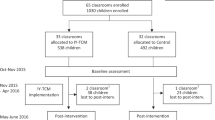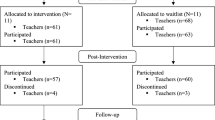Abstract
The Incredible Years Teacher Classroom Management (IY TCM) programme has shown promise in reducing behaviour problems among high-risk children in childcare. However, at present, we do not know whether the IY TCM successfully improves the child–teacher relationship in childcare and whether the effects manifest in both the population and in high-risk groups. Hence, we conducted a quasi-experimental pre-post study with a matched control condition to examine the changes in child–teacher relationships in a sample of 1085 children aged 3–6 years after implementing the IY TCM programme. Linear mixed models revealed favourable group-by-time differences benefitting the intervention compared to the control condition. Subgroup analyses of children scoring at or above the 90th percentile on either internalising or externalising behaviour problems showed that the preventive effects persisted in both high-risk subsamples. In sum, the findings indicate that the IY TCM programme does improve child–teacher relationships and that the effect is present for the entire study population as well as children scoring in the clinical range on behaviour problems. This suggests that the application of the IY TCM programme in childcare settings has important preventive effects. Implications and limitations are further discussed.


Similar content being viewed by others
References
Layard R, Clark A, Cornaglia F, Powdthavee N, Vernoit J (2014) What predicts a successful life? A life-course model of well-being. Econ J 124:F720–F738. https://doi.org/10.1111/ecoj.12170
Odgers CL, Moffitt TE, Broadbent JM, Dickson N, Hancox RJ, Harrington H, Poulton R, Sears MR, Thomson WM, Caspi A (2008) Female and male antisocial trajectories: from childhood origins to adult outcomes. Dev Psychopathol 20:673–716. https://doi.org/10.1017/S0954579408000333
Shaw DS, Gilliom M, Ingoldsby EM, Nagin DS (2003) Trajectories leading to school-age conduct problems. Dev Psychol 39:189–200. https://doi.org/10.1037/0012-1649.39.2.189
Fergusson DM, Horwood LJ, Ridder EM (2005) Show me the child at seven: the consequences of conduct problems in childhood for psychosocial functioning in adulthood. J Child Psychol Psychiatry 46:837–849. https://doi.org/10.1111/j.1469-7610.2004.00387.x
Masten AS, Cicchetti D (2010) Developmental cascades. Dev Psychopathol 22:491–495. https://doi.org/10.1017/S0954579410000222
Heckman JJ (2006) Skill formation and the economics of investing in disadvantaged children. Science 312:1900–1902. https://doi.org/10.1126/science.1128898
Sanders MR (1999) Triple P-positive parenting program: towards an empirically validated multilevel parenting and family support strategy for the prevention of behavior and emotional problems in children. Clin Child Fam Psychol Rev 2:71–90. https://doi.org/10.1023/A:1021843613840
August GJ, Realmuto GM, Hektner JM, Bloomquist ML (2001) An integrated components preventive intervention for aggressive elementary school children: the early risers program. J Consult Clin Psychol 69:614–626. https://doi.org/10.1037/0022-006X.69.4.614
Schweinhart LJ, Weikart DP (1997) The high/scope preschool curriculum comparison study through age 23. Early Child Res Q 12:117–143. https://doi.org/10.1016/S0885-2006(97)90009-0
Webster-Stratton C, Reinke WM, Herman KC, Newcomer LL (2011) The incredible years teacher classroom management training: the methods and principles that support fidelity of training delivery. Sch Psych Rev 40:509–529
Pidano AE, Allen AR (2015) The incredible years series: a review of the independent research base. J Child Fam Stud 24:1898–1916. https://doi.org/10.1007/s10826-014-9991-7
Sabol TJ, Pianta RC (2012) Recent trends in research on teacher-child relationships. Attach Hum Dev 14:213–231. https://doi.org/10.1080/14616734.2012.672262
Ainsworth MDS, Blehar MC, Waters E, Wall SN (1978) Patterns of attachment: a psychological study of the strange situation. Erlbaum, Hillsdale
Verschueren K, Koomen HM (2012) Teacher–child relationships from an attachment perspective. Attach Hum Dev 14:205–211. https://doi.org/10.1080/14616734.2012.672260
Ahnert L, Pinquart M, Lamb ME (2006) Security of children’s relationships with nonparental care providers: a meta-analysis. Child Dev 77:664–679. https://doi.org/10.1111/j.1467-8624.2006.00896.x
Buyse E, Verschueren K, Doumen S (2011) Preschoolers’ attachment to mother and risk for adjustment problems in kindergarten: can teachers make a difference? Soc Dev 20:33–50. https://doi.org/10.1111/j.1467-9507.2009.00555.x
Cornelius-White J (2007) Learner-centered teacher-student relationships are effective: a meta-analysis. Rev Educ Res 77:113–143. https://doi.org/10.3102/003465430298563
McGrath KF, Van Bergen P (2015) Who, when, why and to what end? Students at risk of negative student–teacher relationships and their outcomes. Educ Res Rev 14:1–17. https://doi.org/10.1016/j.edurev.2014.12.001
Hamre BK, Pianta RC (2005) Can instructional and emotional support in the first-grade classroom make a difference for children at risk of school failure? Child Dev 76:949–967. https://doi.org/10.1111/j.1467-8624.2005.00889.x
Ladd GW, Burgess KB (2001) Do relational risks and protective factors moderate the linkages between childhood aggression and early psychological and school adjustment? Child Dev 72:1579–1601. https://doi.org/10.1111/1467-8624.00366
Buyse E, Verschueren K, Doumen S, Van Damme J, Maes F (2008) Classroom problem behavior and teacher-child relationships in kindergarten: the moderating role of classroom climate. J Sch Psychol 46:367–391. https://doi.org/10.1016/j.jsp.2007.06.009
Doumen S, Verschueren K, Buyse E, Germeijs V, Luyckx K, Soenens B (2008) Reciprocal relations between teacher–child conflict and aggressive behavior in kindergarten: a three-wave longitudinal study. J Clin Child Adolesc Psychol 37:588–599. https://doi.org/10.1080/15374410802148079
Webster-Stratton C (2001) The incredible years: parents, teachers, and children training series. Resid Treat Child Youth 18:31–45. https://doi.org/10.1300/J007v18n03_04
Webster-Stratton C (1994) The incredible years teacher training series. Incredible Years, Seattle
Fossum S, Handegård BH, Drugli MB (2017) The incredible years teacher classroom management programme in Kindergartens: effects of a universal preventive effort. J Child Fam Stud 26:2215–2223. https://doi.org/10.1007/s10826-017-0727-3
Aasheim M, Reedtz C, Handegård BH, Martinussen M, Mørch W-T (2018) Evaluation of the incredible years teacher classroom management program in a regular Norwegian school setting. Scand J Educ Res. https://doi.org/10.1080/00313831.2018.1466357
Baker-Henningham H, Scott S, Jones K, Walker S (2012) Reducing child conduct problems and promoting social skills in a middle-income country: cluster randomised controlled trial. Br J Psychiatry 201:101–108. https://doi.org/10.1192/bjp.bp.111.096834
Raver CC, Jones SM, Li-Grining C, Zhai F, Metzger MW, Solomon B (2009) Targeting children’s behavior problems in preschool classrooms: a cluster-randomized controlled trial. J Consult Clin Psychol 77:302–316. https://doi.org/10.1037/a0015302
Williford AP, Shelton TL (2008) Using mental health consultation to decrease disruptive behaviors in preschoolers: adapting an empirically-supported intervention. J Child Psychol Psychiatry 49:191–200. https://doi.org/10.1111/j.1469-7610.2007.01839.x
Carlson JS, Tiret HB, Bender SL, Benson L (2011) The influence of group training in the Incredible Years teacher classroom management program on preschool teachers’ classroom management strategies. J Appl Sch Psychol 27:134–154. https://doi.org/10.1080/15377903.2011.565277
Shernoff ES, Kratochwill TR (2007) Transporting an evidence-based classroom management program for preschoolers with disruptive behavior problems to a school: an analysis of implementation, outcomes, and contextual variables. Sch Psychol Q 22:449–472. https://doi.org/10.1037/1045-3830.22.3.449
Statistics Norway (2018) Kindergartens - annually, final figures. https://www.ssb.no/en/utdanning/statistikker/barnehager/aar-endelige. Accessed 28 Jun 2019
Act no. 64 (2005) The Kindergarten Act. Ministry of Education and Research, Oslo
Achenbach TM, Rescorla LA (2000) Manual for the ASEBA preschool forms & profiles: child behavior checklist for ages 1 1/2-5, language development survey, caregiver - teacher report form: an integrated system of multi-informant assessment. ASEBA, Burlington
Snijders TAB, Bosker RJ (1999) Multilevel analysis: an introduction to basic and applied multilevel analysis. Sage, London
Scherbaum CA, Ferreter JM (2009) Estimating statistical power and required sample sizes for organizational research using multilevel modeling. Org Res Methods 12:347–367. https://doi.org/10.1177/1094428107308906
Lake S, Kammann E, Klar N, Betensky R (2002) Sample size re-estimation in cluster randomization trials. Stat Med 21:1337–1350. https://doi.org/10.1002/sim.1121
Webster-Stratton C (2011) Promoting positive academic and social behaviors. The teachers and children series. A video-based course (Lederveiledning - Norwegian edition). Incredible Years, Seattle, WA
Pianta RC (2001) Student–Teacher Relationship Scale: professional manual. Psychological Assessment Resources, Odessa
Drugli MB, Hjemdal O (2013) Factor structure of the student–teacher relationship scale for Norwegian school-age children explored with confirmatory factor analysis. Scand J Educ Res 57:457–466. https://doi.org/10.1080/00313831.2012.656697
Tsigilis N, Gregoriadis A (2008) Measuring teacher–child relationships in the Greek kindergarten setting: a validity study of the student–teacher relationship scale-short form. Early Educ Dev 19:816–835. https://doi.org/10.1080/10409280801975826
Kristensen S, Henriksen TB, Bilenberg N (2010) The child behavior checklist for ages 1.5–5 (CBCL/1½–5): assessment and analysis of parent-and caregiver-reported problems in a population-based sample of Danish preschool children. Nord J Psychiatry 64:203–209. https://doi.org/10.3109/08039480903456595
Feingold A (2013) A regression framework for effect size assessments in longitudinal modeling of group differences. Rev Gen Psychol 17:111–121. https://doi.org/10.1037/a0030048
Singer JD, Willett JB, Willett JB (2003) Applied longitudinal data analysis: modeling change and event occurrence. Oxford University Press, Oxford, UK. https://doi.org/10.1093/acprof:oso/9780195152968.001.0001
Cohen J (1988) Statistical power analysis for the behavioral sciences, 2nd edn. Laurence Erlbaum, Hillsdale
Rose G (1981) Strategy of prevention: lessons from cardiovascular disease. Br Med J (Clin Res Ed) 282:1847–1851. https://doi.org/10.1136/bmj.282.6279.1847
McLaren L, McIntyre L, Kirkpatrick S (2009) Rose’s population strategy of prevention need not increase social inequalities in health. Int J Epidemiol 39:372–377. https://doi.org/10.1093/ije/dyp315
Henricsson L, Rydell A-M (2004) Elementary school children with behavior problems: teacher–child relations and self-perception. A prospective study. Merrill Palmer Q 50:111–138. https://doi.org/10.1353/mpq.2004.0012
Hamre BK, Pianta RC (2001) Early teacher–child relationships and the trajectory of children’s school outcomes through eighth grade. Child Dev 72:625–638. https://doi.org/10.1111/1467-8624.00301
Neal JW, Durbin CE, Gornik AE, Lo SL (2017) Codevelopment of preschoolers’ temperament traits and social play networks over an entire school year. J Pers Soc Psychol 113:627–640. https://doi.org/10.1037/pspp0000135
Drugli MB, Larsson B, Fossum S, Mørch WT (2010) Five-to six-year outcome and its prediction for children with ODD/CD treated with parent training. J Child Psychol Psychiatry 51:559–566. https://doi.org/10.1111/j.1469-7610.2009.02178.x
Reid MJ, Webster-Stratton C, Hammond M (2003) Follow-up of children who received the Incredible Years intervention for oppositional-defiant disorder: maintenance and prediction of 2-year outcome. Behav Ther 34:471–491. https://doi.org/10.1016/S0005-7894(03)80031-X
Raver CC, Jones SM, Li-Grining CP, Metzger M, Champion KM, Sardin L (2008) Improving preschool classroom processes: preliminary findings from a randomized trial implemented in head start settings. Early Child Res Q 23:10–26. https://doi.org/10.1016/j.ecresq.2007.09.001
Backer TE (2000) The failure of success: challenges of disseminating effective substance abuse prevention programs. J Commun Psychol 28:363–373. https://doi.org/10.1002/(SICI)1520-6629(200005)28:3%3c363:AID-JCOP10%3e3.0.CO;2-T
Harris AD, McGregor JC, Perencevich EN, Furuno JP, Zhu J, Peterson DE, Finkelstein J (2006) The use and interpretation of quasi-experimental studies in medical informatics. J Am Med Inf Assoc 13:16–23. https://doi.org/10.1197/jamia.M1749
Shadish W, Cook TD, Campbell DT (2002) Experimental and quasi-experimental designs for generalized causal inference. Houghton Mifflin, Boston
Ialongo NS, Werthamer L, Kellam SG, Brown CH, Wang S, Lin Y (1999) Proximal impact of two first-grade preventive interventions on the early risk behaviors for later substance abuse, depression, and antisocial behavior. Am J Commun Psychol 27:599–641. https://doi.org/10.1023/A:1022137920532
Acknowledgements
The authors wish to thank Professor Willy-Tore Mørch for his contribution to the study design, Anne-Kari Johnsen, Merete Aasheim and Oddbjørn Løndal for acquisition of data, parents for their willingness to participate, and the childcare teachers for completing the assessments.
Author information
Authors and Affiliations
Corresponding author
Ethics declarations
Conflict of interest
The authors declare that they have no conflict of interest.
Ethical approval
All the procedures performed in studies involving human participants were in accordance with the ethical standards of the institutional and/or national research committee and with the 1964 Helsinki Declaration and its later amendments or comparable ethical standards.
Informed consent
Informed consent was obtained from all individual participants included in the study.
Rights and permissions
About this article
Cite this article
Tveit, H.H., Drugli, M.B., Fossum, S. et al. Does the Incredible Years Teacher Classroom Management programme improve child–teacher relationships in childcare centres? A 1-year universal intervention in a Norwegian community sample. Eur Child Adolesc Psychiatry 29, 625–636 (2020). https://doi.org/10.1007/s00787-019-01387-5
Received:
Accepted:
Published:
Issue Date:
DOI: https://doi.org/10.1007/s00787-019-01387-5




